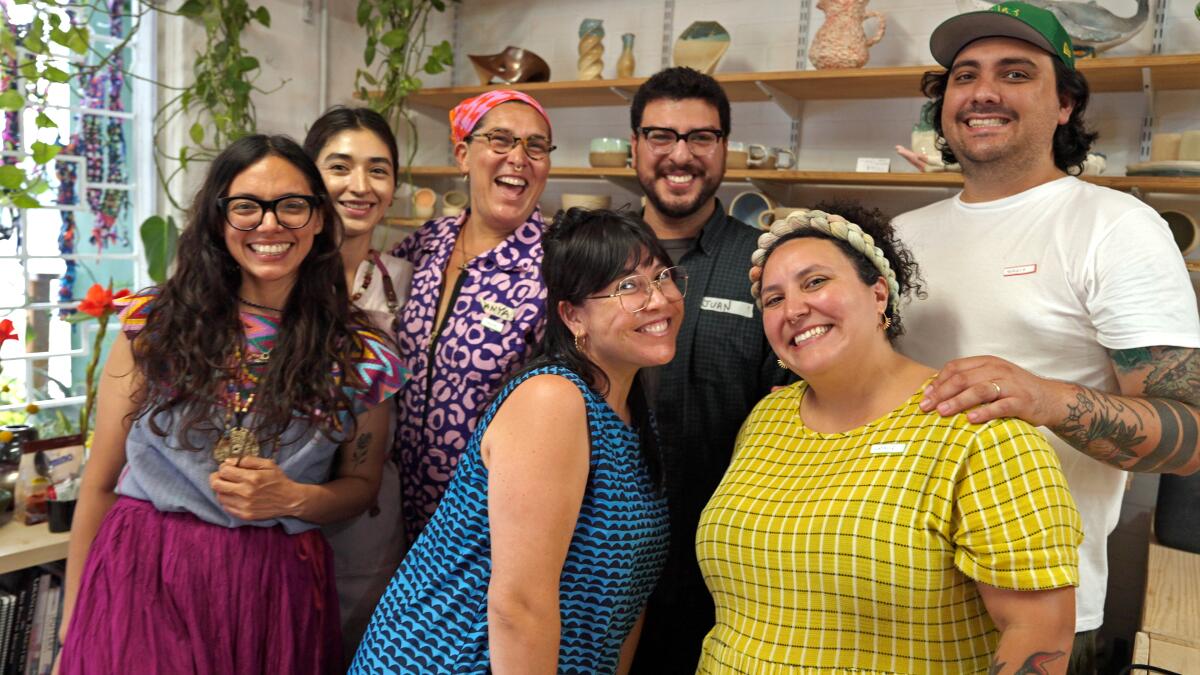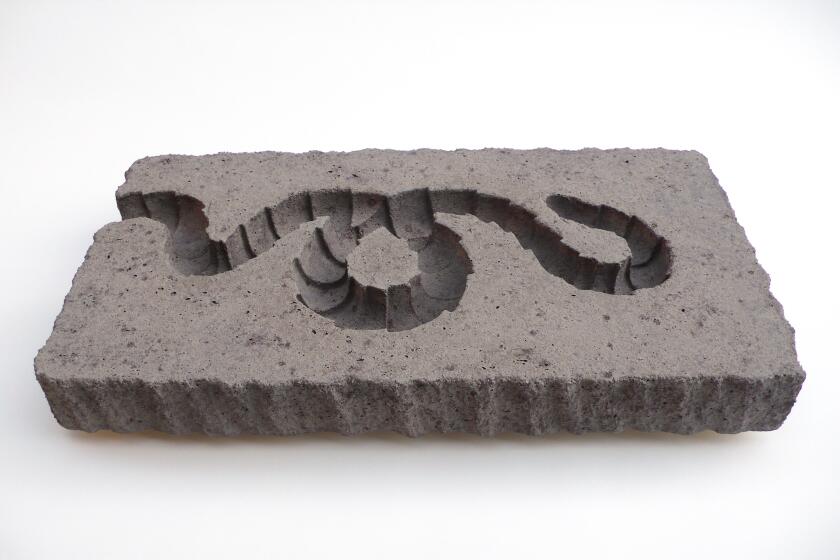Art collective AMBOS brings its outreach to Made in L.A. with an interactive, outstretched hand sculpture

- Share via
In 2017, L.A.-based artist Natalie M. Godinez, who works with textiles and printmaking, was in the process of refining her artistic practice. She wanted to expand on storytelling through art. Then, after collaborating with several artist workshops with AMBOS, a collective founded by artist Tanya Aguiñiga, Godinez had a breakthrough.
Through the hands-on classes, Godinez was surprised to find herself connecting with her own lineage, as someone who grew up on the U.S.-Mexico border, in Tijuana. She wasn’t alone: In the workshops, fellow artists were eager to share more about how the process of craft had unlocked something for them too.
Some participants in the workshops, working with pliable clay that molded to the grooves of their hands, reminisced about using Play-Doh as children. Grandmothers told stories of their mothers teaching them to embroider. Godinez says the experience felt similar to cooking, in that participants bonded over a communal experience. “The act of getting together and making art together is really transformative,” she says.
By collecting and framing contemporary art and ephemera, the Los Angeles Contemporary Archive is lifting the veil on the art-making process.
Aguiñiga founded AMBOS, an acronym for Art Made Between Opposite Sides, in 2016 to address ongoing immigration issues at the border through craft and humanitarian aid. Comprised of nine artists and an evolving group of supporting talent, the group has traversed the U.S.-Mexico border engaging people in artistic projects.
AMBOS has brought its work to the Hammer Museum’s recently opened biennial “Made in L.A.: Acts of Living” exhibition with an interactive installation titled “Con nuestras manos construimos deidades / With our hands we build deities.” Made up of ceramic hands woven together across a free-form structure filled with aromatic herbs, the piece was created by AMBOS Ceramics program students in Tijuana. Viewers are invited to hold hands with the ceramic creations, relating to their creators at the border. Interviews with the students — all of whom share how craft draws them to culture — play from the center of the piece on a loop for visitors to hear. The installation is a culmination of work by 237 people whose names are presented on a wall beside the installation at the Westwood museum, representing the community that made it.
“You can read an article about what’s happening at the border, but actually getting to hold something that someone else made, now you’re responsible for contributing to that,” says Karla Aguíñiga, AMBOS member and Tanya’s sister.

AMBOS’ work extends beyond creating craft works like the one on display at the Hammer Museum. It began as a way for Tanya Aguíñiga to continue the work of the Border Art Workshop/Taller de Arte Fronterizo collective. Co-founded by her mentor Michael Schnorr in 1984, it produced similar work in Tijuana with migrant communities. After Schnorr’s death in 2012, the workshop fizzled. She took up the reins in 2016, calling the new collective AMBOS.
Tanya Aguíñiga sought to offer aid through crafts at a time when Donald Trump’s anti-immigration rhetoric was becoming more pervasive. “I just got really worried about our community in Tijuana and wanted a reason, and a project, to check in with people and make sure that they were OK,” she says.
Her efforts centered on the transnational community in San Diego and Tijuana, the same community she grew up in. Over three years, she brought a team together and expanded AMBOS’ reach to Brownsville, Texas, and Matamoros, Mexico. Godinez, who joined AMBOS in those early days, witnessed the impacts of Trump’s rhetoric — from family separations at the border and people waiting for asylum to the construction of a taller border fence.
“Those phases of the project was a lot more about documentation and bringing awareness to what the border actually looks like,” Godinez says.
Luis Bermudez, who worked for decades as a sculptor and educator in Los Angeles and died in 2021, is one of the artists featured in this year’s Hammer Museum biennial.
Border Quipu (Quipu Fronterizo), AMBOS’ inaugural project, invited people commuting at the border to add a knot to a quipu, an Andean, pre-Columbian system of recording history on colored threads. The AMBOS team walked from car to car traveling across the border, asking them to tie the threads into knots for the project. The collective also offered people note cards to reflect on their perceptions of immigration. By the end of the project, which ran from 2016 to 2018, the quipu included 18 ropes of thread comprised of countless knots. The group eventually displayed the knots on a billboard at the Tijuana-San Diego border.
AMBOS’ current venture into ceramics started virtually in 2020. It kicked off as a temporary program for residents of Jardin de Las Mariposas, an LGBTQ+ center and rehabilitation shelter for migrants and refugees in Tijuana. The program soon expanded into in-person instruction led by queer ceramic artist Juan Villavicencio.
Villavicencio views ceramics as an act of memory. During the program, participants opened up about their family histories in Central American countries like Honduras, El Salvador or Guatemala. Many had a lineage of ceramicists, “but they didn’t have the opportunity to work with the material before,” Villavicencio says. “It was very emotional.”
He was assisted by a therapist from Centro 32/Families Belong Together Mexico during the workshops, because the stories many migrants share often have roots in trauma such as gender-based violence and persecution in their home countries. Offering people the opportunity to create with clay is a liberating experience for him. The program started as a weekly offering to a single facility and has since expanded to Casa Arcoiris in Tijuana. Over the years, Villavicencio has helped students get their work into exhibitions and visit museums. Often the work created goes on to be sold to help fund further programming.
“Every week, people have this space to gather and gossip and hang out and make stuff and have a moment of joy,” says Karla Aguíñiga.
Handmade modern: Tanya Aguiñiga on ‘Craft in America’
The resources to make AMBOS projects possible also are community-based. They often turn to the ceramics community in SoCal for donations of repurposed clay, materials and equipment. AMBOS started its work with a Creative Capital grant and went on to receive a $5,000 grant from the Craft Futures Fund to start AMBOS Ceramics and hire Villavicencio for the workshops. Other forms of income have included fundraisers at Frieze, which have brought in thousands of dollars each year.
The money has gone into funding classes, therapists and unexpected expenses that come along with working with vulnerable communities — such as cleaning supplies, food and other necessities. The team hopes to become a nonprofit organization to expand its offerings to those at the border and in shelters.
“We can’t just be like, ‘Oh, we’re just here to do art’ when they don’t even have trash cans or there’s no running water,” says Karla Aguíñiga. “Sometimes some of the funding goes to emergency aid.”
“Made in L.A.” curators Pablo José Ramírez and Diana Nawi were attracted to AMBOS’ work because of the group’s scope of community engagement. The duo had been in conversation with AMBOS for about a year, talking directly with Tanya Aguíñiga and following the installation’s development. “AMBOS is a community project,” says Ramírez. “It feeds from a collective practice, bringing artistic methodologies and community in unique and powerful ways.”
As Tanya Aguíñiga describes it, AMBOS offers tangible art and intangible knowledge-sharing.
In Tijuana, the same city where AMBOS centers its work, people living outside the shelter “confront this community that they choose to ignore, and it’s really getting them to see the other,” says Karla Aguíñiga.
Tanya Aguíñiga sees craft as “magic,” bringing together people from all backgrounds. Crafts, like ceramics, often are considered practices reserved for academia. However, everyone, no matter their financial status or age, encounters materials such as fiber and clay in their daily life whether they realize it or not, she says.
“Some of the power is that it’s a way of flattening hierarchies,” she adds.
In doing workshops and programs through AMBOS, migrants will often say “I can’t do art, no soy artista,” she recalls. That changes once they hold clay or thread in their hands.
“You share the small amount of whatever material and it starts activating people’s memories,” says Tanya Aguíñiga. “Suddenly, people start thinking about other things. It provides an escape.”
Conversation: Tanya Aguiñiga & AMBOS: Art Made Between Opposite Sides
Where: Hammer Museum, 10899 Wilshire Blvd., Los Angeles
When: 7:30 p.m. Wednesday, Nov. 8
Tickets: Free
Details: hammer.ucla.edu
More to Read
The biggest entertainment stories
Get our big stories about Hollywood, film, television, music, arts, culture and more right in your inbox as soon as they publish.
You may occasionally receive promotional content from the Los Angeles Times.













